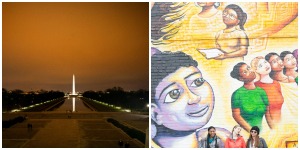
Left: The District’s famous Washington Monument, frequented by tourists. Right: a mural in Brookland, a less-visited neighborhood that has attracted visitors with its art.
By Lanie Rivera
Editor
District Mayor Vincent Gray recently proposed a budget for fiscal year 2014 that would raise the public city arts budget by $2.3 million; city officials wish to invest the funds into neighborhood art projects to encourage tourists to visit under-trafficked areas of the District, according to the Washington Examiner.
I hold the belief that this infusion of funding is an attempt by Gray and other city officials to create a city with appealing aspects beyond its historical and political landmarks.
And if neighborhoods and historic landmarks were equally inviting, I would also argue that the duality of the District would intertwine. Washington, the political, wealthy city, would merge with D.C., the multigenerational residents who have a stake in the District.
Lionell Thomas, executive director of the DC Commission on the Arts and Humanities, told the Examiner that the neighborhood projects would establish the whole District as an artistic epicenter:
People think of the Mall as the place to go for artistic activities … The new strategy creates that whole vision — the city is a vibrant and wonderful place.
And an influx of visitors in lesser-visited neighborhoods would likely promote neighborhood beautification and renovation. Neighborhood visitors would see there is more to the District than the famous statues and museums that people typically plan to visit.
Furthermore, tourism in both Washington (museums and politics) and D.C. (neighborhoods and local hangouts) would weave the two parts together. This contrast is well explained by Adam Serwer in a 2011 article titled “A City Divided,” published on the American Prospect:
Washington spills out of downtown Metro stations at 8 A.M.; D.C. huddles on crowded buses at 6 A.M. On Sundays, when Washington goes to brunch, D.C. is in church. Washington clinks glasses in bars like Local 16 in its leisure time, while D.C. sweats out its perm at dance clubs like Love or DC Star. Washington has health-insurance benefits, but D.C. is paying out of pocket …
Although this duality has existed for quite a while, these two parts of the District have, arguably, already begun to meld together within the past few years, but not equally — some residents believe Washington has overshadowed D.C.
In his 2013 State of the District Address (according to the prepared text), Gray said that the District is becoming a higher class area. The city was previously recognized for its cultural and economic diversity; the career-focused transplants from all over the country mingled with the District locals whose families had grown up in the area for generations.
Now, though, Gray noted that he was afraid the city was overwhelmingly inhabited by residents with white collar careers:
We once worried about the District becoming a city of “haves” and “have-nots.” But now we are increasingly in danger of becoming a city of only “haves.”
Some District natives have noticed the same shift.
NY Times writer Latoya Peterson, a District resident, shared her experience with the city’s divide that confirmed Gray’s worry. She wrote that the political bustle of Washington is taking over D.C. in her January 2013 op-ed piece:
My block today looks completely different from the way it did when I moved in just a few years ago. Italian wine bars and trendy street food arrived, bringing a diversity-lite mix of patrons. Washington is taking over, yet vestiges of D.C. remain.
Under-trafficked neighborhoods may be considered these “vestiges.” If tourists were drawn into local neighborhoods, I argue that central Washington and hidden D.C. would be equally celebrated. Art installations, as suggested by city officials, would be one method to entice visitors into neighborhoods and promote equality among the two faces of the city.
Although I have not read any residents’ reactions to this proposition, many officials have endorsed the idea. At-large Councilman David Grosso told the Examiner that an artistic landmark would create a well-rounded city, adding a creative, authentic flare to a predominantly federal city:
Just like Chicago has “The Bean” (officially titled Cloud Gate), a shiny, odd-looking, permanent fixture of Millennium Park that draws flocks of gaping onlookers, the District needs its own distinctive centerpiece, [Grosso] reasons – not another obelisk for a former president.
Grosso and others think that the District is not a large player in the arts scene. These city officials support Gray’s decision to fund the arts because most big cities have large art pieces that attract visitors.
Jennifer Cover Payne, head of the Cultural Alliance of Greater Washington, told the Examiner that she believes the Gray’s proposition is a great sign following years of an artistic drought.
” ‘When there was an downturn in the economy, the arts downturned even more,’ she said. ‘Now … D.C. is ready for a renaissance.’ “
[WC: 777]


